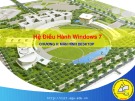Chapter 13: I/O Systems
Silberschatz, Galvin and Gagne ©2009 Silberschatz, Galvin and Gagne ©2009 Operating System Concepts – 8th Edition 13.1 Operating System Concepts – 8th Edition
Chapter 13: I/O Systems
n
I/O Hardware
n
Application I/O Interface
n
Kernel I/O Subsystem
n
Transforming I/O Requests to Hardware Operations
n
STREAMS
n
Performance
Silberschatz, Galvin and Gagne ©2009 13.2 Operating System Concepts – 8th Edition
Objectives
n
Explore the structure of an operating system’s I/O subsystem
n
Discuss the principles of I/O hardware and its complexity
n
Provide details of the performance aspects of I/O hardware and software
Silberschatz, Galvin and Gagne ©2009 13.3 Operating System Concepts – 8th Edition
Overview
n
I/O management is a major component of operating system design and operation
l Important aspect of computer operation l I/O devices vary greatly l Various methods to control them l Performance management l New types of devices frequent
n
Ports, busses, device controllers connect to various devices
n
Device drivers encapsulate device details
l Present uniform device-access interface to I/O subsystem
Silberschatz, Galvin and Gagne ©2009 13.4 Operating System Concepts – 8th Edition
I/O Hardware
n
Incredible variety of I/O devices
l Storage l Transmission l Human-interface
n
Common concepts – signals from I/O devices interface with computer
l Port – connection point for device l Bus - daisy chain or shared direct access l Controller (host adapter) – electronics that operate port, bus, device
4 Sometimes integrated
4 Sometimes separate circuit board (host adapter)
4 Contains processor, microcode, private memory, bus controller, etc
– Some talk to per-device controller with bus controller, microcode, memory, etc
Silberschatz, Galvin and Gagne ©2009 13.5 Operating System Concepts – 8th Edition
A Typical PC Bus Structure
Silberschatz, Galvin and Gagne ©2009 13.6 Operating System Concepts – 8th Edition
I/O Hardware (Cont.)
n
I/O instructions control devices
n
Devices usually have registers where device driver places commands, addresses, and data to write, or read data from registers after command execution
l Data-in register, data-out register, status register, control register l Typically 1-4 bytes, or FIFO buffer
n
Devices have addresses, used by
l Direct I/O instructions l Memory-mapped I/O
4 Device data and command registers mapped to processor address space
4 Especially for large address spaces (graphics)
Silberschatz, Galvin and Gagne ©2009 13.7 Operating System Concepts – 8th Edition
Device I/O Port Locations on PCs (partial)
Silberschatz, Galvin and Gagne ©2009 13.8 Operating System Concepts – 8th Edition
Polling
n
For each byte of I/O
1.
Read busy bit from status register until 0
2.
Host sets read or write bit and if write copies data into data-out register
3.
Host sets command-ready bit
4.
Controller sets busy bit, executes transfer
5.
Controller clears busy bit, error bit, command-ready bit when transfer done
n
Step 1 is busy-wait cycle to wait for I/O from device
l. Reasonable if device is fast l. But inefficient if device slow l. CPU switches to other tasks?
4 But if miss a cycle data overwritten / lost
Silberschatz, Galvin and Gagne ©2009 13.9 Operating System Concepts – 8th Edition
Interrupts
n
Polling can happen in 3 instruction cycles
l Read status, logical-and to extract status bit, branch if not zero l How to be more efficient if non-zero infrequently?
n
CPU Interrupt-request line triggered by I/O device l Checked by processor after each instruction
n
Interrupt handler receives interrupts
n
l Maskable to ignore or delay some interrupts Interrupt vector to dispatch interrupt to correct handler
l Context switch at start and end l Based on priority l Some nonmaskable l Interrupt chaining if more than one device at same interrupt number
Silberschatz, Galvin and Gagne ©2009 13.10 Operating System Concepts – 8th Edition
Interrupt-Driven I/O Cycle
Silberschatz, Galvin and Gagne ©2009 13.11 Operating System Concepts – 8th Edition
Intel Pentium Processor Event-Vector Table
Silberschatz, Galvin and Gagne ©2009 13.12 Operating System Concepts – 8th Edition
Interrupts (Cont.)
n
Interrupt mechanism also used for exceptions
l Terminate process, crash system due to hardware error
n
Page fault executes when memory access error
n
System call executes via trap to trigger kernel to execute request
n Multi-CPU systems can process interrupts concurrently l If operating system designed to handle it
n
Used for time-sensitive processing, frequent, must be fast
Silberschatz, Galvin and Gagne ©2009 13.13 Operating System Concepts – 8th Edition
Direct Memory Access
n
Used to avoid programmed I/O (one byte at a time) for large data movement
n
Requires DMA controller
n
Bypasses CPU to transfer data directly between I/O device and memory
n OS writes DMA command block into memory l Source and destination addresses l Read or write mode l Count of bytes l Writes location of command block to DMA controller l Bus mastering of DMA controller – grabs bus from CPU l When done, interrupts to signal completion
Silberschatz, Galvin and Gagne ©2009 13.14 Operating System Concepts – 8th Edition
Six Step Process to Perform DMA Transfer
Silberschatz, Galvin and Gagne ©2009 13.15 Operating System Concepts – 8th Edition
Application I/O Interface
n
I/O system calls encapsulate device behaviors in generic classes
n
Device-driver layer hides differences among I/O controllers from kernel
n
New devices talking already-implemented protocols need no extra work
n
Each OS has its own I/O subsystem structures and device driver frameworks
n
Devices vary in many dimensions l Character-stream or block l Sequential or random-access l Synchronous or asynchronous (or both) l Sharable or dedicated l Speed of operation l read-write, read only, or write only
Silberschatz, Galvin and Gagne ©2009 13.16 Operating System Concepts – 8th Edition
A Kernel I/O Structure
Silberschatz, Galvin and Gagne ©2009 13.17 Operating System Concepts – 8th Edition
Characteristics of I/O Devices
Silberschatz, Galvin and Gagne ©2009 13.18 Operating System Concepts – 8th Edition
Characteristics of I/O Devices (Cont.)
n
Subtleties of devices handled by device drivers
n
Broadly I/O devices can be grouped by the OS into
l Block I/O l Character I/O (Stream) l Memory-mapped file access l Network sockets
n
For direct manipulation of I/O device specific characteristics, usually an escape / back door
l Unix ioctl() call to send arbitrary bits to a device control register and data to device data register
Silberschatz, Galvin and Gagne ©2009 13.19 Operating System Concepts – 8th Edition
Block and Character Devices
n
Block devices include disk drives
l Commands include read, write, seek l Raw I/O, direct I/O, or file-system access l Memory-mapped file access possible
4 File mapped to virtual memory and clusters brought via demand paging
l DMA
n
Character devices include keyboards, mice, serial ports
l Commands include get(), put() l Libraries layered on top allow line editing
Silberschatz, Galvin and Gagne ©2009 13.20 Operating System Concepts – 8th Edition
Network Devices
n
Varying enough from block and character to have own interface
n
Unix and Windows NT/9x/2000 include socket interface l Separates network protocol from network operation l Includes select() functionality
n
Approaches vary widely (pipes, FIFOs, streams, queues, mailboxes)
Silberschatz, Galvin and Gagne ©2009 13.21 Operating System Concepts – 8th Edition
Clocks and Timers
n
Provide current time, elapsed time, timer
n
Normal resolution about 1/60 second
n
Some systems provide higher-resolution timers
n
Programmable interval timer used for timings, periodic interrupts
n
ioctl() (on UNIX) covers odd aspects of I/O such as clocks and timers
Silberschatz, Galvin and Gagne ©2009 13.22 Operating System Concepts – 8th Edition
Blocking and Nonblocking I/O
n
Blocking - process suspended until I/O completed
l Easy to use and understand l Insufficient for some needs
n
Nonblocking - I/O call returns as much as available
l User interface, data copy (buffered I/O) l Implemented via multi-threading l Returns quickly with count of bytes read or written l select() to find if data ready then read() or write() to transfer
n
Asynchronous - process runs while I/O executes
l Difficult to use l I/O subsystem signals process when I/O completed
Silberschatz, Galvin and Gagne ©2009 13.23 Operating System Concepts – 8th Edition
Two I/O Methods
Synchronous
Asynchronous
Silberschatz, Galvin and Gagne ©2009 13.24 Operating System Concepts – 8th Edition
Kernel I/O Subsystem
n
Scheduling
l Some I/O request ordering via per-device queue l Some OSs try fairness l Some implement Quality Of Service (i.e. IPQOS)
n
Buffering - store data in memory while transferring between devices
l To cope with device speed mismatch l To cope with device transfer size mismatch l To maintain “copy semantics” l Double buffering – two copies of the data
4 Kernel and user
4 Varying sizes
4 Full / being processed and not-full / being used
4 Copy-on-write can be used for efficiency in some cases
Silberschatz, Galvin and Gagne ©2009 13.25 Operating System Concepts – 8th Edition
Device-status Table
Silberschatz, Galvin and Gagne ©2009 13.26 Operating System Concepts – 8th Edition
Sun Enterprise 6000 Device-Transfer Rates
Silberschatz, Galvin and Gagne ©2009 13.27 Operating System Concepts – 8th Edition
Kernel I/O Subsystem
n
Caching - faster device holding copy of data
l Always just a copy l Key to performance l Sometimes combined with buffering
n
Spooling - hold output for a device
l If device can serve only one request at a time l i.e., Printing
n
Device reservation - provides exclusive access to a device
l System calls for allocation and de-allocation l Watch out for deadlock
Silberschatz, Galvin and Gagne ©2009 13.28 Operating System Concepts – 8th Edition
Error Handling
n OS can recover from disk read, device unavailable, transient write failures
l Retry a read or write, for example l Some systems more advanced – Solaris FMA, AIX
4 Track error frequencies, stop using device with increasing frequency of retry-able errors
n Most return an error number or code when I/O request fails
n
System error logs hold problem reports
Silberschatz, Galvin and Gagne ©2009 13.29 Operating System Concepts – 8th Edition
I/O Protection
n
User process may accidentally or purposefully attempt to disrupt normal operation via illegal I/O instructions
l All I/O instructions defined to be privileged l I/O must be performed via system calls
4 Memory-mapped and I/O port memory locations must be protected too
Silberschatz, Galvin and Gagne ©2009 13.30 Operating System Concepts – 8th Edition
Use of a System Call to Perform I/O
Silberschatz, Galvin and Gagne ©2009 13.31 Operating System Concepts – 8th Edition
Kernel Data Structures
n
Kernel keeps state info for I/O components, including open file tables, network connections, character device state
n Many, many complex data structures to track buffers, memory allocation, “dirty” blocks
n
Some use object-oriented methods and message passing to implement I/O
l Windows uses message passing
4 Message with I/O information passed from user mode into kernel
4 Message modified as it flows through to device driver and back to process
4 Pros / cons?
Silberschatz, Galvin and Gagne ©2009 13.32 Operating System Concepts – 8th Edition
UNIX I/O Kernel Structure
Silberschatz, Galvin and Gagne ©2009 13.33 Operating System Concepts – 8th Edition
I/O Requests to Hardware Operations
n
Consider reading a file from disk for a process:
l Determine device holding file l Translate name to device representation l Physically read data from disk into buffer l Make data available to requesting process l Return control to process
Silberschatz, Galvin and Gagne ©2009 13.34 Operating System Concepts – 8th Edition
Life Cycle of An I/O Request
Silberschatz, Galvin and Gagne ©2009 13.35 Operating System Concepts – 8th Edition
STREAMS
n
STREAM – a full-duplex communication channel between a user-level process and a device in Unix System V and beyond
n
A STREAM consists of:
- STREAM head interfaces with the user process
- driver end interfaces with the device - zero or more STREAM modules between them
n
Each module contains a read queue and a write queue
n Message passing is used to communicate between queues l Flow control option to indicate available or busy
n
Asynchronous internally, synchronous where user process communicates with stream head
Silberschatz, Galvin and Gagne ©2009 13.36 Operating System Concepts – 8th Edition
The STREAMS Structure
Silberschatz, Galvin and Gagne ©2009 13.37 Operating System Concepts – 8th Edition
Performance
n
I/O a major factor in system performance:
l Demands CPU to execute device driver, kernel I/O code l Context switches due to interrupts l Data copying l Network traffic especially stressful
Silberschatz, Galvin and Gagne ©2009 13.38 Operating System Concepts – 8th Edition
Intercomputer Communications
Silberschatz, Galvin and Gagne ©2009 13.39 Operating System Concepts – 8th Edition
Improving Performance
n
Reduce number of context switches
n
Reduce data copying
n
Reduce interrupts by using large transfers, smart controllers, polling
n
Use DMA
n
Use smarter hardware devices
n
Balance CPU, memory, bus, and I/O performance for highest throughput
n Move user-mode processes / daemons to kernel threads
Silberschatz, Galvin and Gagne ©2009 13.40 Operating System Concepts – 8th Edition
Device-Functionality Progression
Silberschatz, Galvin and Gagne ©2009 13.41 Operating System Concepts – 8th Edition
End of Chapter 12
Silberschatz, Galvin and Gagne ©2009 Silberschatz, Galvin and Gagne ©2009 Operating System Concepts – 8th Edition 13.42 Operating System Concepts – 8th Edition













































